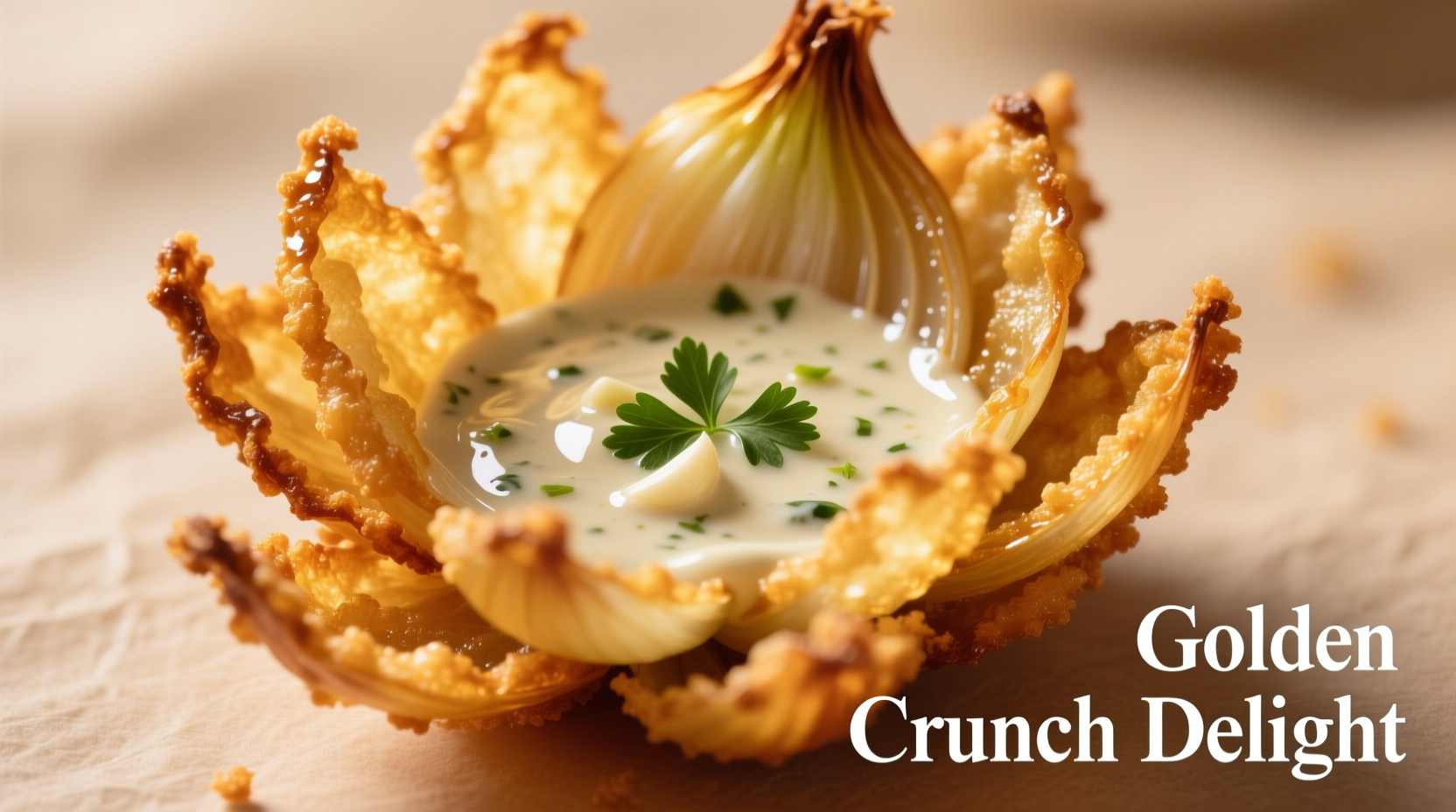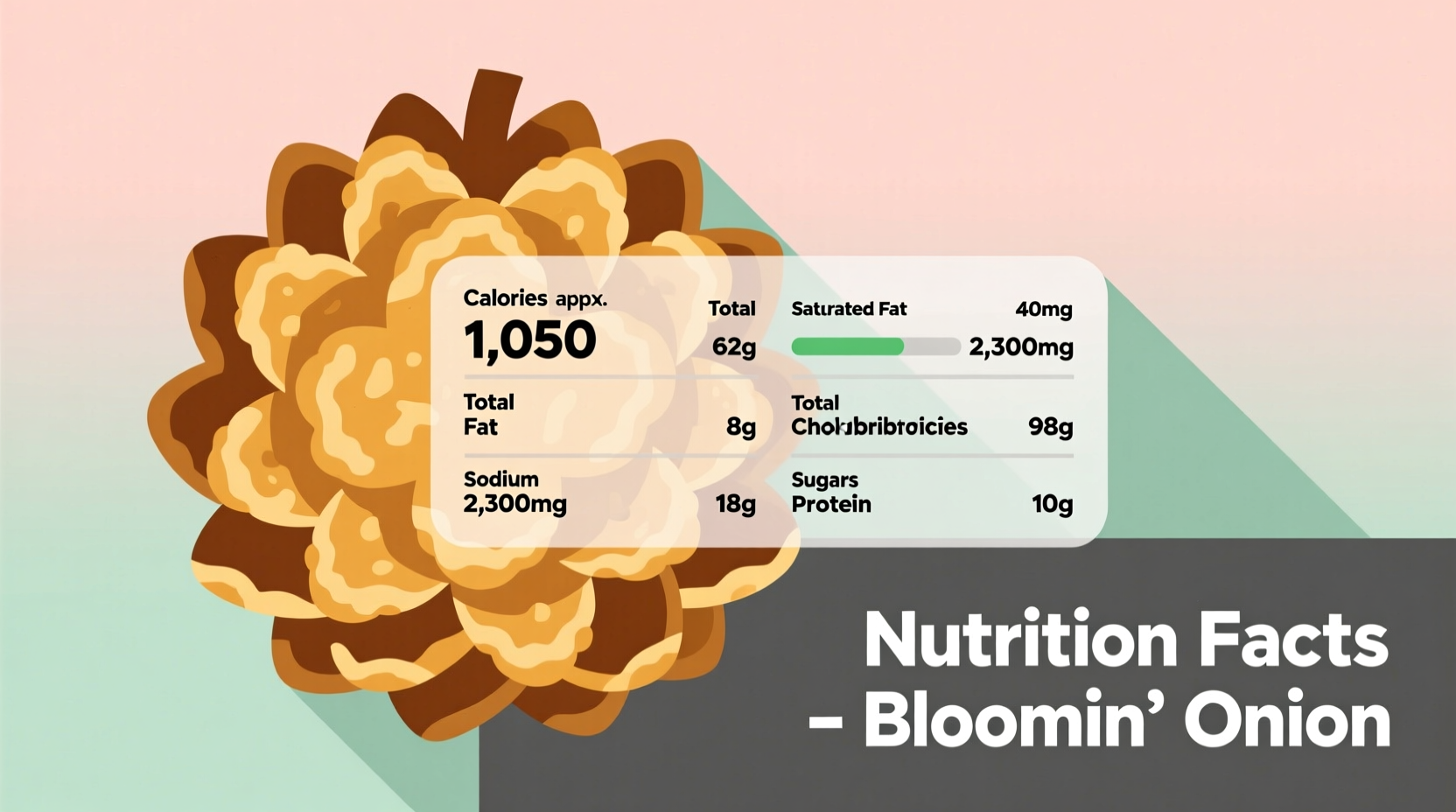One serving of bloomin onion (approximately 1/4 of the whole appetizer) contains 890 calories, 52g fat (16g saturated), 98g carbohydrates, and 1,300mg sodium. This popular restaurant appetizer delivers minimal nutritional benefits compared to raw onions while packing significant calories and sodium from deep frying and seasoning.
When you order that tempting bloomin onion appetizer at your favorite steakhouse, you're getting far more than just onions. Understanding bloomin onion nutrition facts is crucial for making informed dining choices, especially when this menu favorite appears on tables across America. As a culinary professional who's worked in both fine dining and casual restaurant settings, I've seen firsthand how this iconic appetizer impacts diners' nutritional intake.
Nutritional Profile of a Classic Bloomin Onion
The bloomin onion isn't just an onion—it's an entire culinary experience that transforms a simple vegetable into a calorie-dense indulgence. While a raw medium onion contains just 44 calories and 10g carbohydrates, the deep-fried version undergoes a dramatic nutritional transformation.
| Nutrient | Bloomin Onion (1/4 serving) | Raw Medium Onion | Difference |
|---|---|---|---|
| Calories | 890 | 44 | +1923% |
| Total Fat | 52g | 0.1g | +51,900% |
| Saturated Fat | 16g | 0g | N/A |
| Carbohydrates | 98g | 10g | +880% |
| Sodium | 1,300mg | 4mg | +32,400% |
| Fiber | 6g | 2g | +200% |
| Vitamin C | 10% DV | 11% DV | -9% |
This dramatic nutritional shift occurs because of the preparation method. The USDA FoodData Central database confirms that deep frying significantly alters the nutritional composition of vegetables, adding substantial fat and calories while reducing certain heat-sensitive nutrients. The bloomin onion's distinctive flavor comes from a combination of batter, deep frying, and seasoning blend that transforms its nutritional profile completely.
Understanding the Preparation Impact
The bloomin onion's journey from simple vegetable to restaurant staple involves several nutritional-altering steps:
- Selection: Typically made with sweet Vidalia or Walla Walla onions
- Preparation: Cutting into flower shape and soaking in milk or buttermilk
- Battering: Dipping in seasoned flour or beer batter
- Frying: Deep frying at 350-375°F until golden brown
- Seasoning
According to research published in the Journal of Food Science, deep frying vegetables at high temperatures causes significant oil absorption—typically 8-25% of the final product's weight. This explains the dramatic fat increase compared to raw onions. The batter contributes additional carbohydrates and sodium, while the frying process reduces certain heat-sensitive nutrients like vitamin C.

Health Considerations and Practical Guidance
While bloomin onions deliver minimal nutritional benefits compared to their raw counterparts, they do contain some positive elements. Onions naturally contain quercetin, a flavonoid with antioxidant properties that remains relatively stable during cooking. However, the high calorie and sodium content means you should approach this appetizer with awareness.
Registered dietitians from the Academy of Nutrition and Dietetics recommend considering these bloomin onion nutritional facts for health-conscious dining:
- Share one bloomin onion among 3-4 people to reduce individual intake
- Request sauce on the side to control additional calories
- Balance your meal with lean protein and vegetables
- Consider it an occasional treat rather than regular menu item
For those monitoring sodium intake, the American Heart Association notes that the 1,300mg sodium in one serving represents over half the recommended daily limit for most adults. This bloomin onion sodium content analysis is particularly important for individuals with hypertension or cardiovascular concerns.
When Might a Bloomin Onion Fit Your Diet?
Understanding the nutritional value of bloomin onion helps determine appropriate consumption contexts. While not a health food, it can fit into balanced eating patterns when approached mindfully:
- Social dining occasions: When sharing with others as part of a special meal
- Active individuals: Those with higher caloric needs may accommodate it more easily
- After exercise: The carbohydrates can help replenish glycogen stores
However, for individuals managing weight, blood pressure, or metabolic conditions, the bloomin onion calorie count and health impact warrants caution. The Cleveland Clinic's nutrition department advises that occasional indulgence is acceptable, but regular consumption of high-calorie appetizers can undermine health goals.
Healthier Alternatives Worth Considering
If you enjoy the flavor profile but want better bloomin onion nutritional comparison options, consider these alternatives:
- Grilled onion petals: Achieve similar presentation with minimal added fat
- Oven-roasted onions: Concentrates natural sweetness without deep frying
- Raw onion salads: Preserves maximum nutritional benefits
- Air-fried versions: Reduces oil absorption by 70-80% compared to deep frying
Research from the USDA Food Patterns shows that preparing vegetables with minimal added fats preserves more of their natural nutritional benefits while reducing unnecessary calories. These alternatives deliver the onion's natural flavor and nutritional benefits without the excessive fat and sodium of the traditional bloomin onion preparation.
Practical Takeaways for Mindful Dining
When faced with the tempting bloomin onion on a restaurant menu, keep these practical considerations in mind:
- Ask about portion size—some restaurants serve individual portions while others expect sharing
- Request nutritional information if available—many chain restaurants now provide this
- Consider ordering a side salad first to help manage overall appetite
- Choose water or unsweetened tea instead of sugary beverages to balance the meal
Remember that understanding bloomin onion nutrition information for restaurant dining empowers you to make choices aligned with your health goals without sacrificing enjoyment. The key isn't elimination but mindful incorporation into your overall eating pattern.











 浙公网安备
33010002000092号
浙公网安备
33010002000092号 浙B2-20120091-4
浙B2-20120091-4